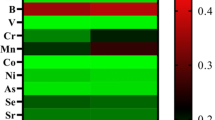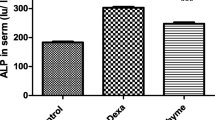Abstract
It has been demonstrated that administration of high concentrations of monosodium glutamate (MSG), induce oxidative stress in different organs, but not in thymus. In the present study we examined the role of oxidative stress in MSG-induced thymocyte apoptosis. MSG was administrated intraperitoneally (4 mg/g of body weight) for six consecutive days. Animals were sacrificed at 1st, 7th, and 15th day after last MSG dose. MSG administration to animals significantly increased apoptotic rate of thymocytes (P < 0.01), together with significant increase of malondialdehyde (MDA) level (P < 0.001) and xanthine oxidase (XO) activity (P < 0.01), in time dependent manner. Catalase activity, during examination period, was significantly decreased (0 < 0.01). Obtained results showed that MSG treatment induced oxidative stress in thymus, which may have an important role in thymocyte apoptosis induced by MSG.



Similar content being viewed by others
References
Castro L, Freeman BA (2001) Reactive oxygen species in human health and disease. Nutrition 17:161–165
Bonnefont-Rousselot D, Bastard JP, Jaudon MC et al (2000) Consequences of the diabetic status on the oxidant/antioxidant balance. Diabet Metabol 26:163–176
Rollet -Labelle E, Grange MJ, Elbim C et al (1998) Hydroxyl radical as a potential intracellular mediator of polymorphonuclear neutrophil apoptosis. Free Radic Biol Med 24:563–572
Kannak K, Jain SK (2000) Oxidative stress and apoptosis. Pathophysiology 7:153–163
Knight JA (2000) Review: free radicals, antioxidants and the immune system. Ann Clin Lab Sci 30:145–158
Hildeman DA, Mitchell T, Aronow B et al (2003) Control of Bcl-2 expression by reactive oxygen species. Proc Natl Acad Sci 100:15035–15040
Gill SS, Pulido OM (2001) Glutamate receptors in peripheral tissues: current knowledge, future research, and implications for toxicology. Toxicol Pathol 29:208–223
Skerry TM, Genever PG (2001) Glutamate signalling in non-neuronal tissues. Trends Pharmacol Sci 22:174–181
Hinoi E, Takarada T, Ueshima T et al (2004) Glutamate signaling in peripheral tissues. Eur J Biochem 271:1–13
Lombardi G, Disanzani C, Miglio G et al (2001) Characterization of ionotropic glutamate receptors in human lymphocytes. Br J Pharmacol 133:936–944
Ganor Y, Besser M, Ben-Zakay N et al (2003) Human T-cells express a functional ionotropic glutamate receptor GluR3, and glutamate by itself triggers integrin-mediated adhesion to laminin and fibronectin and chemotactic migration. J Immunol 170:4362–4372
Storto M, Grazia U, Battaglia G et al (2000) Expression of metabotropic glutamate receptors in murine thymocytes and thymic stromal cells. J Neuroimmunol 109:112–120
Rezzani R, Corsetti G, Rodella L et al (2003) Cyclosporine-A treatment inhibits the expression of metabotropic glutamate receptors in rat thymus. Acta Histochem 105:81–87
Pavlovic V, Cekic S, Sokolovic D et al (2006) Modulatory effect of monosodium glutamate on rat thymocyte proliferation and apoptosis. Brat Lek Listy 107:185–191
Farombi EO, Onyema OO (2006) Monosodium glutamate-induced oxidative damage and genotoxicity in the rat: modulatory role of vitamin C, vitamin E and quercetin. Hum Exp Toxicol 25:251–259
Singh P, Mann AK, Mangat HK et al (2003) Prolonged glutamate excitotoxicity: Effects on mitochondrial antioxidants and antioxidant enzymes. Mol Cell Biochem 243:139–145
Trobonjaca Z, Radosevic-Stasic B, Crncevic Z et al (2001) Modulatory effects of octreotide on anti-CD3 and dexamethasone-induced apoptosis of murine thymocytes. Int Immunopharmacol 1:1753–1764
Hayashi M, Nagata A, Endoh D et al (2002) High sensitivity of thymocytes of LEC strain rats to induction of apoptosis by X-radiation. J Vet Med Sci 64:597–601
Vermes I, Haanen C, Steffens-Nakken H et al (1995) A novel assay for apoptosis. Flow cytometric detection of phosphatidylserine expression on early apoptotic cells using fluorescein labelled Annexin V. J Immunol Methods 184:39–51
Koopman G, Reutelingsperger CP, Kuijten GA et al (1994) Annexin V for flow cytometric detection of phosphatidylserine expression on B cells undergoing apoptosis. Blood 84:1415–1420
Okasha SA, Ryu S, Do Y et al (2001) Evidence for estradiol-induced apoptosis and dysregulated T cell maturation in the thymus. Toxicology 163:49–62
Lecoeur H, Prevost MC, Gougeon ML (2001) Oncosis is associated with exposure of phosphatidylserine residues on the outside layer of the plasma membrane: a reconsideration of the specificity of the annexin V/propidium iodide assay. Cytometry 44:65–72
Ohkawa H, Ohishi N, Yagi K (1979) Assay for lipid peroxides in animal tissues by thiobarbituric acid reaction. Anl Biochem 95:351–358
Kazaki H, Sakurada T (1977) Simple micro-assay methods for enzymes of purine metabolism. J Lab Clin Med 89:1135–1144
Hashimoto JA (1974) New spectrophotometric assay method of xanthine oxidase in crude tissue homogenate. Anal Biochem 62:426–435
Koroliuk MA, Ivanova LI, Maiorova IG et al (1988) A method of determining catalase activity. Lab Delo 1:16–9
Lowry O, Roseenbrough N, Farr A (1951) Protein measurment with Folin phenol reagent. J Biol Chem 193:167–175
Savino W, Dardenne M (2000) Neuroendocrine control of thymus physiology. Endo Rev 21:412–443
Pavlovic V, Cekic S (2006) The effect of monosodium glutamate on rat thymocyte proliferation and Bcl-2/Bax protein expresssion. Arch Med Sci 4: 247–251
Schelman WR, Andres RD, Sipe KJ et al (2004) Glutamate mediates cell death and increases the Bax to Bcl-2 ratio in a differentiated neuronal cell line. Brain Res Mol Brain Res 128:160–169
Martin LJ, Sieber FE, Traystman RJ (2000) Apoptosis and necrosis occur in separate neuronal populations in hippocampus and cerebellum after ischemia and are associated with differential alterations in metabotropic glutamate receptor signaling pathways. J Cereb Blood Flow Metab 20:153–167
Miglio G, Varsaldi F, Dianzani C et al (2005) Stimulation of group I metabotropic glutamate receptors evokes calcium signals and c-jun and c-fos gene expression in human T cells. Biochem Pharmacol 70:189–199
Kroemer GB, Esche-Rigon D (1998) The mitochondrial death/life regulator in apoptosis and necrosis. Annu Rev Physiol 60:619–642
Luetjens CM, Bui NT, Sengpiel B et al (2000) Delayed mitochondrial dysfunction in excitotoxic neuron death: cytochrome c release and a secondary increase in superoxide production. J Neurosci 20:5715–5723
Latha B, Babu M (2001) The involvement of free radicals in burn injury: a review. Burns 27:309–317
Gutterridge JC (1995) Lipid peroxidation and antioxidants as biomarkers of tissue damage. Clin Chem 41:1819–1828
Choudhary P, Malik VT, Puri S et al (1996): Studies of the effect of monosodium glutamate on hepatic microsomal lipid peroxidation, calcium, ascorbic acid and glutathione and its dependent enzymes in adult male mice. Toxicol Lett 89:71–76
Warner DS, Sheng H, Batinic-Haberle I (2004) Oxidants, antioxidants and the ischemic brain. J Exp Biol 207:3221–3231
Jaeschke H (2002) Xanthine oxidase-induced oxidant stress during hepatic ischemia-reperfusion: are we coming full circle after 20 years? Hepatology 36:761–763
Zeki S, Miura S, Suzuki H et al (2002) Xanthine oxidase-derived oxygen radicals play significant roles in the development of chronic pancreatitis in WBN/Kob rats. Gastroenterol Hepatol 17:606–616
Ates O, Cayli SR, Altinoz E et al (2006) Neuroprotective effect of mexiletine in the central nervous system of diabetic rats. Mol Cell Biochem 286:125–131
Curtin JF, Donovan M, Cotter TG (2002) Regulation and measurment of oxidative stress in apoptosis. J Immunol Methods 265:49–72
Singh K, Ahluwalia P (2003) Studies on the effects of monosodium glutamate (MSG) administration on some antioxidant enzymes in the arterial tissue of adult male mice. J Nutr Sci Vitaminol 49:145–148
Tome ME, Baker AF, Powis G et al (2001) Catalase-overexpressing thymocytes are resistant to glucocorticoid-induced apoptosis and exhibit increased net tumor growth. Cancer Res 61:2766–2773
Lledias F, Rangel P, Hansberg W (1998) Oxidation of catalase by singlet oxygen. J Biol Chem 273:10630–10637
Kaushik S, Kaur J (2003) Chronic cold exposure affects the antioxidant defense system in various rat tissues. Clin Chim Acta 333:69–77
Acknowledgements
This work was supported by the Ministry of Science and Environmental Protection of Serbia (Project 145081).
Author information
Authors and Affiliations
Corresponding author
Rights and permissions
About this article
Cite this article
Pavlovic, V., Pavlovic, D., Kocic, G. et al. Effect of monosodium glutamate on oxidative stress and apoptosis in rat thymus. Mol Cell Biochem 303, 161–166 (2007). https://doi.org/10.1007/s11010-007-9469-7
Received:
Accepted:
Published:
Issue Date:
DOI: https://doi.org/10.1007/s11010-007-9469-7




